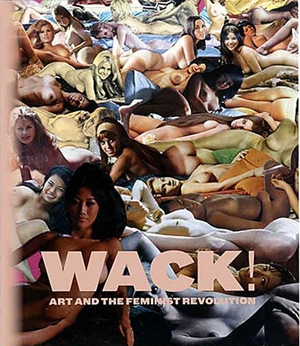Remember way back in 2007 when feminism was all hot again? When Martha Rosler’s cacophony of exploited naked babes were – not uncontroversially – used on the cover of the catalogue for WACK: Art and the Feminist Revolution?
Jeremy Strick, director of LA’s MOCA, commented at the time: ‘In 2007 numerous institutions around the country are presenting programs that shed light on women’s history and the broad network of activity that characterises its impact within the artworld’. There was much talk of ‘waves’, ‘groundswells’ and suchlike. The Elizabeth A. Sackler Center for Feminist Art opened at the Brooklyn Museum last year too, acquiring Judy Chicago’s seminal Dinner Party (1974–79; take a tour of it here). Around the same time in Europe, Amsterdam-based organisation If I Can’t Dance, I Don’t Want To Be Part Of Your Revolution kicked off a programme exploring the legacy of feminism on contemporary artists, including Keren Cytter, Falke Pisano, Frances Stark alongside the likes of Gerard Byrne and Yael Davids. The programme is now a permanent foundation and tours to major institutions around the Netherlands, Denmark and Spain. In all, there were enough major art shows for Ms. Magazine to publish a Feminist Art Calendar for 2007.
So, if there is some kind of wave of new critical feminist interest from artists, curators and institutions (part of a more general return to identity politics?), how has the UK responded? Has the wave built to tsunami strength or is it now a ripple in a teacup?
First off, the Turner Prize this year features three female artists: Goshka Macuga, Cathy Wilkes and Runa Islam, alongside Mark Leckey. Perhaps we have indeed caught the wave, because there were several exhibitions of female artists in the UK this summer that seemed to present, in a strong physical way, questions about particularities and social realities for women and girls. There was Pipilotti Rist’s playful and seductive show at FACT in Liverpool, and Mona Hatoum’s extremely refined blend of discomfort and familiarity at Parasol Unit.
Karla Black’s exhibition at West London Projects, using all manner of feminine lotions and potions, drew on both the legacy of performative feminist artists and psychoanalysis as well as the canonised art history of the object/non object.
Aforementioned Turner nominee Cathy Wilkes had a brief solo exhibition in August at the Modern Institute, in Glasgow.
Wilkes’ customary female mannequins were present, and as with her previous work, they appeared like abused objects, alongside a supermarket shopping till covered in baby food ephemera and porridge. Wilkes’ installations often feel violent and limiting, and the female figures as creatures of severely limited options. All movement is frozen here, socially and financially.
Which brings me to my ‘late summer’ point: that is, the work-a-day question of women artists making a living. The restructuring of the British art calendar brought about by Frieze means that late summer is the perfect time to see a show by a female artist, before we get serious about collectors and money in October. Many commercial galleries have placed the female members of their stable safely into the summer slots.
A quick count of male to female shows in major to medium-sized commercial galleries in London during October reveals a ratio of 38 male to five female. That means just 11.6 per cent of galleries will have solo shows by women. It’s as if, when it’s time to get down to business, gallerists in London collectively reach into their back pocket to bring out their biggest male gun. (Henry Moore! Richard Serra!) If the British artworld is to really catch the ‘post-feminist’ wave at all, then gallerists will have to give their collectors a chance to do so. If you are a female artist standing at the supermarket checkout, then this is part of the change that matters.
Here’s a full gender break down of major exhibitions in London this October:
Male
Lisson: Julian Opie
Haunch of Venison: Rafael Lozano Hemmer
White Cube Hoxton Square: Josiah McElheny
White Cube Mason’s Yard: Robert Irwin
Gagosian: Richard Serra
Kate McGarry: Matt Bryans
Stuart Shave: David Altmeid
Hauser & Wirth: Henry Moore
Paradise Row: Adam Broomberg and Oliver Chanarin
Parasol Unit: Charles Avery
Max Wigram: Julian Rosefeldt
Sadie Coles Heddon Street: Florian Hecker
Sadie Coles Balfour Mews: Gabriel Kuri
Victorial Miro: Elmgreen & Dragset
Victoria Miro: Phillip Pearlstein
Alison Jacques: Thomas Zipp
The Approach E2: Patrick Hill
The Approach W1: Edward Lipski
Corvi-Mora: Roger Hiorns
David Risley: James Aldridge
Fred: Philip Jones
Frith Street Gallery: Giuseppe Penone
Greengrassi: Giuseppe Gabellone
Herald St: Thomas Housego
Hollybush Gardens: Przemek Matecki
Hotel: Steven Claydon
Karsten Schubert: Matt Mullican
Limoncello: Tom Gidley
Museum 52: Philip Hausmeier
Maureen Paley: Banks Violette
Rokeby: Sam Dargan
Simon Lee: Toby Ziegler
Spring Projects: Peter Friedl
Store: Ryan Gander
Sutton Lane: John Miller
Keith Talent: Bob Matthews
Vilma Gold: Felix Gmelin
Wilkinson: Clegg & Guttman
Female
Timothy Taylor: Mai-Thu Perret
Stephen Friedman: Catherine Opie
Laura Bartlett: Nina Beier & Marie Lund
Riflemaker: Chosil Kil
Sadie Coles South Audley Street: Sarah Lucas
